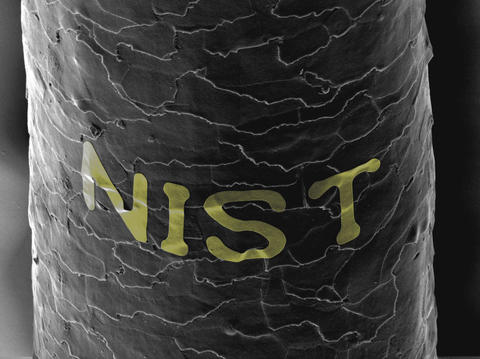2022-11-25 米国国立標準技術研究所(NIST)

Using sugar and corn syrup (i.e., candy), researcher Gary Zabow transferred the word “NIST” onto a human hair in gold letters, shown in false color in this grayscale microscope image.
Credit: G. Zabow/NIST
このような表面に直接パターンを印刷することは難しいため、科学者たちは転写印刷を行っている。しかし、このような固形物は、印刷物を敷き詰めたときに、鋭いカーブやコーナーにうまくフィットしないことがある。また、プラスチックやその他の化学物質が残ってしまい、除去が困難になったり、バイオメディカル用途としては安全でない可能性がある。
また、転写材を水面に浮かべて、その中を対象物が通過するような手法もある。しかし、これも厄介なもので、自由に流れる液体では、新しい表面の希望する場所に正確にプリントを配置することが難しい。
研究者は、カラメル状の砂糖とコーンシロップの単純な組み合わせで、そのようなことができることを発見した。
少量の水に溶かして、平らな面に置いたマイクロパターンにかければいいのである。水分が蒸発すると、飴は固まり、パターンが埋め込まれたまま持ち上げることができる。その後、模様の入った飴を新しい表面に置き、溶かす。砂糖とコーンシロップの組み合わせは、溶けるときに高い粘度を保つので、カーブやエッジに流れても模様の配置を維持することができる。その後、水を使って砂糖を洗い流し、模様だけを残すことができる。
REFLEX(REflow-driven FLExible Xfer)と呼ばれるこの技術を使って、マイクロサーキットのパターンをステンシルのように転写し、科学者やメーカーが必要な材料を適切な場所にエッチングして充填できるようにすることができる。また、パターン化した材料を元のチップからファイバーやマイクロビーズに転写し、生物医学やマイクロロボットの研究に利用したり、新しいデバイスの鋭い表面や曲面上に転写したりすることもできる。
<関連情報>
- https://www.nist.gov/news-events/news/2022/11/nist-finds-sweet-new-way-print-microchip-patterns-curvy-surfaces
- https://www.science.org/doi/10.1126/science.add7023
リフロー転写によるコンフォーマル3次元微細加工 Reflow transfer for conformal three-dimensional microprinting
G. Zabow
Science Published:24 Nov 2022
DOI: 10.1126/science.add7023
Sweetening the transfer printing process
Micropatterning is the fabrication of specifically textured or patterned surfaces through either lithographic methods or the transfer of a prefabricated pattern using a sacrificial layer onto the substrate surface. However, the various methods generally only work for flat or gently curved surfaces. Zabow reports a method to do transfer printing on near arbitrary conformal surfaces using sugar (see the Perspective by Johnson). Corn syrup is added to the sugar to prevent it from crystallizing, and specific mixtures can be used to tailor the transfer substrate properties. Transfer is achieved using only gentle heating, and the sugar is readily dissolved away. Demonstrations include conformal coatings down vertical sidewalls, over sharp edges, and onto single strands of hair. —MSL
Abstract
From microcircuits to metamaterials, the micropatterning of surfaces adds valuable functionality. For nonplanar surfaces, incompatibility with conventional microlithography requires the transfer of originally planar micropatterns onto those surfaces; however, existing approaches accommodate only limited curvatures. A microtransfer approach was developed using reflowable materials that transform between solid and liquid on demand, freely stretching to yield transfers that naturally conform down to nanoscale radii of curvature and arbitrarily complex topographies. Such reflow transfer helps generalize microprinting, extending the reach of precision planar microlithography to highly nonplanar substrates and microstructures. With gentle water-based processing, reflow transfer can be applied to a range of materials, with microprinting demonstrated onto metal, plastic, paper, glass, polystyrene, semiconductor, elastomer, hydrogel, and multiple biological surfaces.



